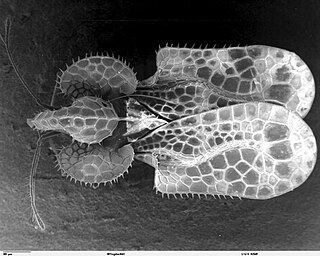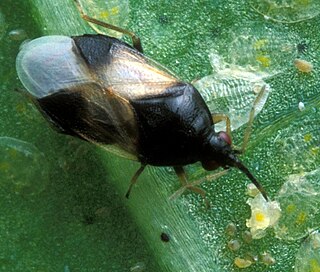
The Cimicomorpha are an infraorder of insects in the order Hemiptera, the true bugs. The rostrum and other morphology of some members apparently is adapted to feeding on animals as their prey or hosts. Members include bed bugs, bat bugs, assassin bugs, and pirate bugs.

Anthocoridae is a family of bugs, commonly called minute pirate bugs or flower bugs. Worldwide there are 500-600 species.

The genus Orius consists of omnivorous bugs in the family Anthocoridae. Adults are 2–5 mm long and feed mostly on smaller insects, larva and eggs, such as spider mites, thrips, jumping plant lice, and white fly, but will also feed on pollen and vascular sap.
Lippomanus is a genus of seed bugs in the subfamily Anthocorinae, erected by William Lucas Distant 1904.

The Microphysidae are a very small family of true bugs, comprising only 5 extant genera.

Orius insidiosus, common name the insidious flower bug, is a species of minute pirate bug, a predatory insect in the order Hemiptera. They are considered beneficial, as they feed on small pest arthropods and their eggs. They are mass-reared for use in the biological control of thrips.

Cardiastethus is a genus of minute pirate bugs in the family Anthocoridae. There are more than 20 described species in Cardiastethus.

Xylocoris is a genus of bugs in the monotypic tribe Xylocorini of the family Anthocoridae. There are approximately 50 described species in Xylocoris worldwide. Nearly 30 species occur in the Palaearctic Region, 10 are known from the Nearctic Region, and 6 from the Oriental Region. They occur in various habitats, often found under plant litter and under tree bark where they feed on small arthropods. Certain species inhabit stored food facilities.

Scoloposcelis is a genus of minute pirate bugs in the family Anthocoridae. There are about seven described species in Scoloposcelis.

Acompocoris is a genus of minute pirate bugs in the family Anthocoridae. There are at least four described species in Acompocoris.
Brachysteles is a genus of minute pirate bugs in the family Anthocoridae. There are at least three described species in Brachysteles.

Dufouriellini is a tribe of minute pirate bugs in the family Anthocoridae. There are about 7 genera and 15 described species in Dufouriellini.
Elatophilus is a genus of minute pirate bugs in the family Anthocoridae. There are about 15 described species in Elatophilus.
Temnostethus is a genus of minute pirate bugs in the family Anthocoridae. There are about eight described species in Temnostethus.
Coccivora is a genus of minute pirate bugs in the family Anthocoridae. There is one described species in Coccivora, C. californica.

Buchananiella is a genus of minute pirate bugs in the family Anthocoridae. There are at least three described species in Buchananiella.
Melanocoris is a genus of minute pirate bugs in the family Anthocoridae. There are at least four described species in Melanocoris.

Dufouriellus is a monotypic genus of minute pirate bugs in the tribe Dufouriellini. The described species is Dufouriellus ater, which has been recorded from much of western Europe through to Bohemia, Moravia, Slovakia, southern Scandinavia and including the British Isles.

Lyctocoridae is a reconstituted family of bugs, formerly classified within the minute pirate bugs of the family Anthocoridae. It is widely distributed, with one species, being cosmopolitan.

Lasiochilinae is a subfamily of bugs, in the family Anthocoridae; some authorities place this at family level: "Lasiochilidae". It is most diverse in tropical areas, especially in the New World.













